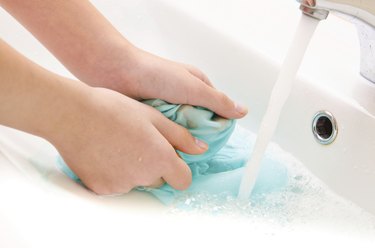
That spaghetti sauce stain on your favorite cardigan went unnoticed for too long, and now you're afraid it won't come out in a standard wash. The longer a stain sits on a garment, the more permanent it becomes, and if it's been exposed to heat, you might think it's game over. Have no fear of set-in stains, though -- many old stains can still be partially or even fully removed, layer by layer, even if they've already been laundered.
Water-Based Stains
Video of the Day
Water-based stains such as coffee and tea, and many foods, are full of acids and lift up with the application of white vinegar. Apply a small amount of white vinegar to food and wine stains, and blot them with a clean white paper towel to remove the top layer of color. Rinse the stain under cool water, and then blot it with dye-free liquid dishwashing detergent. Rinse again and repeat the alternating application of vinegar and detergent until the stain fully lifts; then launder as usual. If the stain does not lift at all, switch gears -- launder with an oxygen-based bleach.
Video of the Day
Oil-Based Stains
Oil-based stains, including paint, food grease and cosmetics, harden differently and need the oil layer removed first before the stain color will come out. Dry solvents often do the trick, but they can also harm some fabrics. Nail polish remover, for example, works on nail polish stains, but will eat away at acetate fabric. Blot polish stains with the remover, and then rinse and launder the garment. Dissolve oil paint with paint solvent; then rinse and blot with a stain remover product before laundering. For food grease, consult a dry cleaner -- dry cleaning chemicals lift grease stains well.
Complex Combination Stains
Many stains have both a water and an oil element, and require special attention with commercial enzyme cleaners made for laundry stains. Dairy stains, grass, smoke, sweat and sebum stains all respond to enzyme cleaners, along with old bloodstains, mud stains and chocolate stains. Dust off any dried material, and then dampen the stain and add a small amount of enzyme cleaner. Soak the clothes in cool water for 30 minutes, and launder as usual. Do not use enzyme cleaner on protein fabrics like wool or silk. For inks or dyes, blot stains with acetone or denatured alcohol; then rinse and launder.
Bleaching Concerns
The last resort for set-in stains is bleach, but be cautious: Silk and wool dissolve in chlorine bleach. If you've exhausted all options and want to run a bleach wash on a truly stubborn stain, first test the colorfastness of the garment. Add 1 part chlorine bleach to 5 parts water, and place a drop of the solution on your garment's seam, or use one drop of color-safe bleach. Blot the bleach, and then let it set for one minute. Rinse the bleached area; blot it dry and check for a color change. If no change occurs, it's safe to use bleach on your garment.